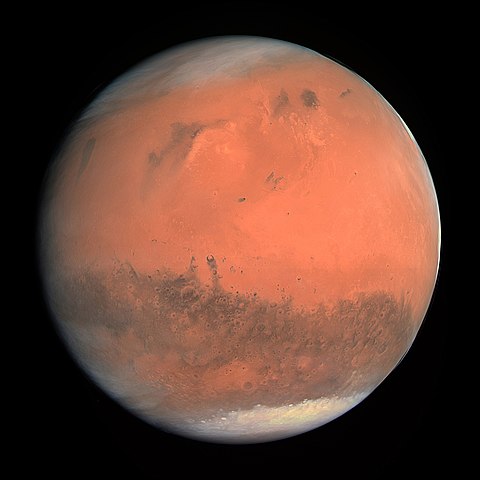Difference between revisions of "Mars"
Occultwiki (talk | contribs) |
Occultwiki (talk | contribs) |
||
| Line 2: | Line 2: | ||
'''Mars''' is the fourth planet from the Sun and the second-smallest planet in the Solar System, being larger than only [[Mercury]]. In English, Mars carries the name of the Roman god of war and is often referred to as the "Red Planet". The latter refers to the effect of the iron oxide prevalent on Mars's surface, which gives it a striking reddish appearance in the sky. Mars is a terrestrial planet with a thin atmosphere, with surface features such as impact craters, valleys, dunes, and polar ice caps. | '''Mars''' is the fourth planet from the Sun and the second-smallest planet in the Solar System, being larger than only [[Mercury]]. In English, Mars carries the name of the Roman god of war and is often referred to as the "Red Planet". The latter refers to the effect of the iron oxide prevalent on Mars's surface, which gives it a striking reddish appearance in the sky. Mars is a terrestrial planet with a thin atmosphere, with surface features such as impact craters, valleys, dunes, and polar ice caps. | ||
The days and seasons are comparable to those of Earth, because the rotation period as well as the tilt of the rotational axis relative to the ecliptic plane are similar. Mars is the site of Olympus Mons, the largest volcano and highest known mountain on any planet in the Solar System, and of Valles Marineris, one of the largest canyons in the Solar System. The smooth Borealis basin in the Northern Hemisphere covers 40% of the planet and may be a giant impact feature. Mars has two moons, Phobos and Deimos, which are small and irregularly shaped. | The days and seasons are comparable to those of [[Earth]], because the rotation period as well as the tilt of the rotational axis relative to the ecliptic plane are similar. Mars is the site of Olympus Mons, the largest volcano and highest known mountain on any planet in the Solar System, and of Valles Marineris, one of the largest canyons in the Solar System. The smooth Borealis basin in the Northern Hemisphere covers 40% of the planet and may be a giant impact feature. Mars has two moons, Phobos and Deimos, which are small and irregularly shaped. | ||
==Early observations== | ==Early observations== | ||
Revision as of 17:57, 9 September 2023
Mars is the fourth planet from the Sun and the second-smallest planet in the Solar System, being larger than only Mercury. In English, Mars carries the name of the Roman god of war and is often referred to as the "Red Planet". The latter refers to the effect of the iron oxide prevalent on Mars's surface, which gives it a striking reddish appearance in the sky. Mars is a terrestrial planet with a thin atmosphere, with surface features such as impact craters, valleys, dunes, and polar ice caps.
The days and seasons are comparable to those of Earth, because the rotation period as well as the tilt of the rotational axis relative to the ecliptic plane are similar. Mars is the site of Olympus Mons, the largest volcano and highest known mountain on any planet in the Solar System, and of Valles Marineris, one of the largest canyons in the Solar System. The smooth Borealis basin in the Northern Hemisphere covers 40% of the planet and may be a giant impact feature. Mars has two moons, Phobos and Deimos, which are small and irregularly shaped.
Early observations
The existence of Mars as a wandering object in the night sky was recorded by ancient Egyptian astronomers. By the 2nd millennium BCE they were familiar with the apparent retrograde motion of the planet, in which it appears to move in the opposite direction across the sky from its normal progression. Mars was portrayed on the ceiling of the tomb of Seti I, on the Ramesseum ceiling, and in the Senenmut star map. The last is the oldest known star map, being dated to 1534 BCE based on the position of the planets.
By the period of the Neo-Babylonian Empire, Babylonian astronomers were making systematic observations of the positions and behavior of the planets. For Mars, they knew, for example, that the planet made 37 synodic periods, or 42 circuits of the zodiac, every 79 years. The Babylonians invented arithmetic methods for making minor corrections to the predicted positions of the planets. This technique was primarily derived from timing measurements—such as when Mars rose above the horizon, rather than from the less accurately known position of the planet on the celestial sphere.
Chinese records of the appearances and motions of Mars appear before the founding of the Zhou Dynasty (1045 BCE), and by the Qin Dynasty (221 BCE) astronomers maintained close records of planetary conjunctions, including those of Mars. Occultations of Mars by Venus were noted in 368, 375, and 405 CE. The period and motion of the planet's orbit was known in detail during the Tang Dynasty (618 CE).
The early astronomy of ancient Greece was influenced by knowledge transmitted from the Mesopotamian culture. Thus, the Babylonians associated Mars with Nergal, their god of war and pestilence, and the Greeks connected the planet with their god of war, Ares. During this period, the motions of the planets were of little interest to the Greeks; Hesiod's Works and Days (c. 650 BCE) makes no mention of the planets.
Later observations
In 1543, Nicolaus Copernicus published a heliocentric model in his work De revolutionibus orbium coelestium. This approach placed the Earth in an orbit around the Sun between the circular orbits of Venus and Mars. His model successfully explained why the planets Mars, Jupiter and Saturn were on the opposite side of the sky from the Sun whenever they were in the middle of their retrograde motions. Copernicus was able to sort the planets into their correct heliocentric order based solely on the period of their orbits about the Sun.
In 1877 Italian astronomer Giovanni Schiaparelli used a 22 cm (8.7 in) telescope to help produce the first detailed map of Mars. These maps notably contained features he called canali, which were later shown to be an optical illusion. These canali were supposedly long straight lines on the surface of Mars to which he gave names of famous rivers on Earth. His term canali was popularly mistranslated in English as "canals." In 1886, the English astronomer William F. Denning observed that these linear features were irregular in nature and showed concentrations and interruptions. By 1895, English astronomer Edward Maunder became convinced that the linear features were merely the summation of many smaller details.
Astrology
Astrologically, is the ruling planet of Aries and is exalted in Capricorn. Mars is the Roman god of war and bloodshed, whose symbol is a spear and shield. Both the soil of Mars and the hemoglobin of human blood are rich in iron and because of this they share its distinct deep red color. He was second in importance only to Jupiter and Saturn, due to Mars being the most prominent of the military gods worshipped by the Roman legions.
Mars is associated with aggression, confrontation, energy, strength, ambition and impulsiveness. Mars governs sports, competitions and physical activities in general. The 1st-century poet Manilius, described the planet as ardent and as the lesser malefic. In medicine, Mars presides over the genitals, the muscular system, the gonads and adrenal glands. It was traditionally held to be hot and excessively dry and rules the choleric humor. It was associated with fever, accidents, trauma, pain and surgery.
In modern astrology, Mars is the primary native ruler of the first house. Traditionally however, Mars ruled both the third and tenth houses, and had its joy in the fifth house. While Venus tends to the overall relationship atmosphere, Mars is the passionate impulse and action, the masculine aspect, discipline, willpower and stamina.

